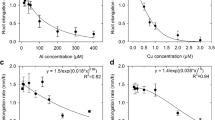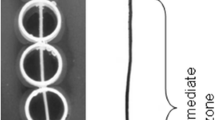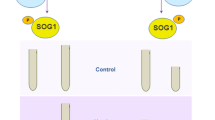Abstract
Several mineral rhizotoxicities, including those induced by Al3+, H+, and Na+, can be relieved by elevated Ca2+ in the rooting medium. This leads to the hypothesis that the toxic cations displace Ca2+ from transport channels or surface ligands that must be occupied by Ca2+ in order for root elongation to occur. In this study with wheat (Triticum aestivum L.) seedlings, we have determined, in the case of Al3+, that (i) Ca2+, Mg2+, and Sr2+ are equally ameliorative, (ii) that root elongation does not increase as Ca2+ replaces Mg2+ or Sr2+ in the rooting media, and (iii) that rhizotoxicity is a function solely of Al3+ activity at the root-cell membrane surface as computed by a Gouy-Chapman-Stern model. The rhizotoxicity was indifferent to the computed membrane-surface Ca2+ activity. The rhizotoxicity induced by high levels of tris(ethylenediamine)cobaltic ion (TEC3+), in contrast to Al3+, was specifically relieved by Ca2+ at the membrane surface. The rhizotoxicity induced by H+ exhibited a weak specific response to Ca2+ at the membrane surface. We conclude that the Ca2+-displacement hypothesis fails in the case of Al3+ rhizotoxicity and that amelioration by cations (including monovalent cations) occurs because of decreased membrane-surface negativity and the consequent decrease in the membrane-surface activity of Al3+. However, TEC3+, but not Al3+, may be toxic because it inhibits Ca2+ uptake. The nature of the specific H+-Ca2+ interaction is uncertain.
Similar content being viewed by others
Abbreviations
- {Al3+ }0 :
-
chemical activity of Al3+ at the root-cell membrane surface
- {Al3+ }E :
-
chemical activity of Al3+ in the external rooting medium
- E0 :
-
electrical potential at the root-cell membrane surface
- HXM2+ :
-
hexamethonium ion
- TEC3+ :
-
tris(ethylenediamine)cobaltic ion
References
Alvarez, O., Brodwick, M., Latorre, R., McLaughlin, A., McLaughlin, S., Szabo, G. (1983) Large divalent cations and electrostatic potentials adjacent to membranes. Biophys. J. 44, 333–342
Barber, J., Searle, G.F.W. (1978) Cation induced increase in chlorophyll fluorescence yield and the effect of electrical charge. FEBS Lett. 92, 5–8
Caldwell, C.R. (1989) Analysis of aluminum and divalent cation binding to wheat root plasma membrane proteins using terbium phosphorescence. Plant Physiol. 91, 233–241
Cramer, G.R., Läuchli, A., Polito, V.S. (1985) Displacement of Ca2+ by Na+ from the plasmalemma of root cells. A primary response to salt stress? Plant Physiol. 79, 207–211
Deleers, M. (1985) Cationic atmosphere and cation competition binding at negatively charged membranes: pathological implications of aluminum. Res. Commun. Chem. Pathol. Pharmacol. 49, 277–294
Foy, C.D. (1984) Physiological effects of hydrogen, aluminum, and manganese toxicities in acid soil. In: Soil acidity and liming, 2nd edn., pp. 57–97, Adams, F., ed. American Society of Agronomy, Madison, Wis.
Hanson, J.B. (1984) The functions of calcium in plant nutrition. In: Advances in plant nutrition, vol 1, pp. 149–208, Tinker, P.B., Läuchli, A., eds. Praeger Scientific, New York
Haug, A., Shi, B. (1991) Biochemical basis of aluminium tolerance in plant cells. In: Plant-soil interactions at low pH, pp. 839–850, Wright, R.J., Baligar, V.C., Murrmann, R.P., eds. Kluwer Academic Publishers, Dordrecht, The Netherlands
Hille, B. (1992) Ionic channels of excitable membranes, 2nd edn. Sinauer Associates, Sunderland, Mass., USA
Huang, J.W., Grunes, D.L., Kochian, L.V. (1992a) Aluminum effects on the kinetics of calcium uptake into cells of the wheat root apex. Quantification of calcium fluxes using a calcium-selective vibrating microelectrode. Planta 188, 414–421
Huang, J.W., Shaff, J.E., Grunes, D.L., Kochian, L.V. (1992b) Aluminum effects on calcium fluxes at the root apex of aluminumtolerant and aluminum-sensitive wheat cultivars. Plant Physiol. 98, 230–237
Johnson, R.E., Jackson, W.A. (1964) Calcium uptake and transport by wheat seedlings as affected by aluminum. Soil Sci. Soc. Am. Proc. 28, 381–386
Kinraide, T.B. (1991) Identity of the rhizotoxic aluminium species. Plant Soil 134, 167–178
Kinraide, T.B. (1993) Aluminum enhancement of plant growth in acid rooting media. A case of reciprocal alleviation of toxicity by two toxic cations. Physiol. Plant., in press
Kinraide, T.B., Parker, D.R. (1987a) Cation amelioration of aluminum toxicity in wheat. Plant Physiol. 83, 546–551
Kinraide, T.B., Parker, D.R. (1987b) Non-phytotoxicity of the aluminum sulfate ion, AlSO +4 . Physiol. Plant 71, 207–212
Kinraide, T.B., Parker D.R. (1989) Assessing the phytotoxicity of mononuclear hydroxy-aluminum. Plant Cell Environ. 12, 479–487
Kinraide, T.B., Ryan, P.R., Kochian, L.V. (1992) Interactive effects of Al3+, H+, and other cations on root elongation considered in terms of cell-surface electrical potential. Plant Physiol. 99, 1461–1468
Lau, A., McLaughlin, A., McLaughlin S. (1981) The adsorption of divalent cations to phosphatidylglycerol bilayer membranes. Biochim. Biophys. Acta. 645, 279–292
Rengel, Z. (1992) Disturbance of cell Ca2+ homeostasis as a primary trigger of Al toxicity syndrome. Plant Cell Environ. 15, 931–938
Ryan, P.R., Kinraide, T.B., Kochian, L.V. (1993) Al3+-Ca2+ interactions in aluminum rhizotoxicity. I. Inhibition of root growth is not caused by reduction of calcium uptake. Planta 192, 98–103
Ryan, P.R., Kochian, L.V. (1993) Interaction between aluminum toxicity and calcium uptake at the root apex in near-isogenic line of wheat (Triticum aestivum L.) differing in aluminum tolerance. Plant Physiol. 102, 975–982
Shi, B., Haug, A. (1992) Aluminium interferes with signal transduction in neuroblastoma cells. Pharmacol. Toxicol. 71, 308–313
Taylor, G.J., Stadt, K.J., Dale, M.R.T. (1992) Modeling the interactive effects of aluminum, cadmium, manganese, nickel and zinc stress using the Weibull frequency distribution. Environ. Exp. Bot. 32, 281–293
Author information
Authors and Affiliations
Rights and permissions
About this article
Cite this article
Kinraide, T.B., Ryan, P.R. & Kochian, L.V. Al3+-Ca2+ interactions in aluminum rhizotoxicity. Planta 192, 104–109 (1993). https://doi.org/10.1007/BF00198699
Received:
Accepted:
Issue Date:
DOI: https://doi.org/10.1007/BF00198699




